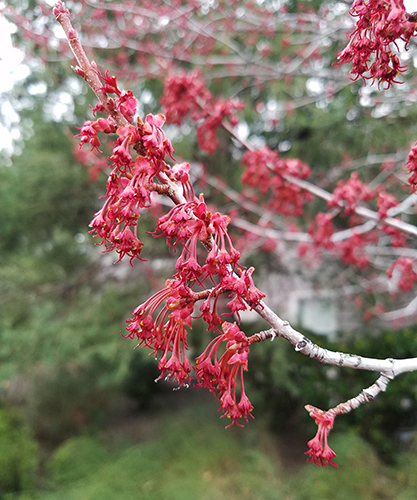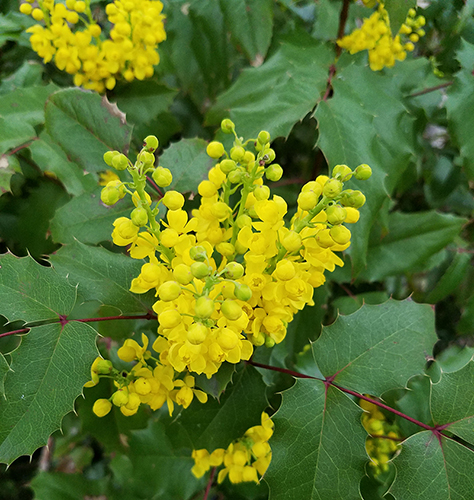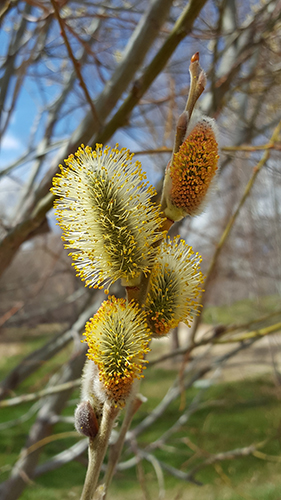 Spring is often referred to as the season of transformation and renewal. Temperatures rise, rainy days begin and flowers appear, signaling gardeners to spring out of their winter funks and begin working their gardens. As you are out in the garden this spring, don’t forget to take some time to bask in the beauty of spring blooms.
Spring is often referred to as the season of transformation and renewal. Temperatures rise, rainy days begin and flowers appear, signaling gardeners to spring out of their winter funks and begin working their gardens. As you are out in the garden this spring, don’t forget to take some time to bask in the beauty of spring blooms.
All over town, daffodils of bright yellow and white, purple-leaf plum trees with soft pink petals and ornamental pear trees with a canopy of white blossoms cover our parks and gardens. Forsythia and Oregon grape are dotted with yellow blooms, and scarlet flowering quince can be spotted as well.
These plants are very common and eye-catching. However, there are many other plants that bloom this time of year, but often go unnoticed. Willows and maples are some of the first trees to bloom, and attract pollinators in late winter or early spring. Their flowers are small and inconspicuous to those not looking for them, but once you know where to look, you will be surprised by their splendor.
 For example, a pussy willow flower is not your traditional petaled flower. Instead, the flower, called a catkin, looks like a fluffy cat tail with a furry layer designed to keep the reproductive parts warm. Pussy willow flowers are actually open flowers, since you can see the pollen-bearing anthers and the female stigmas. These trees are dioecious, meaning that there are separate female and male plants. The male plants are more common, due to their showier flowers and earlier bloom time.
For example, a pussy willow flower is not your traditional petaled flower. Instead, the flower, called a catkin, looks like a fluffy cat tail with a furry layer designed to keep the reproductive parts warm. Pussy willow flowers are actually open flowers, since you can see the pollen-bearing anthers and the female stigmas. These trees are dioecious, meaning that there are separate female and male plants. The male plants are more common, due to their showier flowers and earlier bloom time.
Other trees also have catkins, including aspen, oak, birch, poplar and beech. Long, drooping and yellow-green oak catkins hang off the tips of the branches. Aspen catkins resemble pussy willow catkins with a fuzzy coat. Next time you are near one of these trees, look closely for their unique flowers.
Maples have interesting and lovely flowers that often get overlooked as well. Small, delicate-looking flowers of yellow-green or dark red appear on the tips of branches sometime in March. Red maples have intricate flowers in sprays of crimson that emerge just before the leaves, while Norway maples have yellow-green flower clusters.
 Unlike pussy willows that are dioecious, maples are monoecious, meaning they have both female and male flowers on the same plant. Maple flowers are insect- and wind-pollinated. When the female flowers are fertilized, they will turn into what many children dub helicopters, but botanists call them samaras or winged seeds. If you look closely right now, you can see mini samaras forming on maples.
Unlike pussy willows that are dioecious, maples are monoecious, meaning they have both female and male flowers on the same plant. Maple flowers are insect- and wind-pollinated. When the female flowers are fertilized, they will turn into what many children dub helicopters, but botanists call them samaras or winged seeds. If you look closely right now, you can see mini samaras forming on maples.
You will begin to see more and more blooms over the next few months. If you see a flower and don’t recognize it, we encourage you to take a couple of photos, one of the flower and one of the whole plant, and email or visit your local Cooperative Extension office to have a Master Gardener identify it for you.
Fisher, J.
2018,
What’s blooming now?,
Reno Gazette Journal


